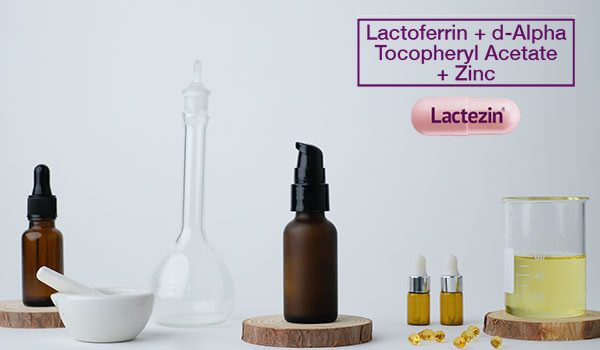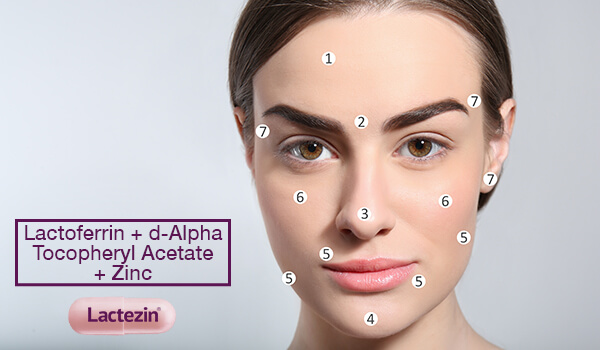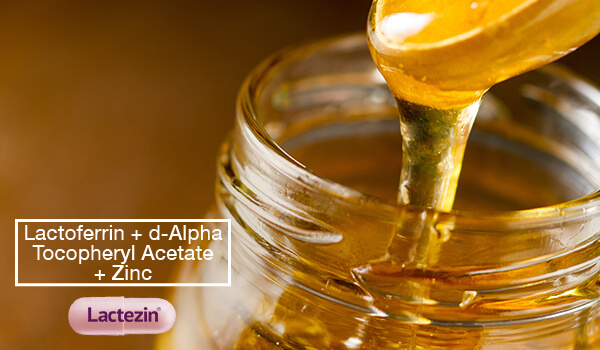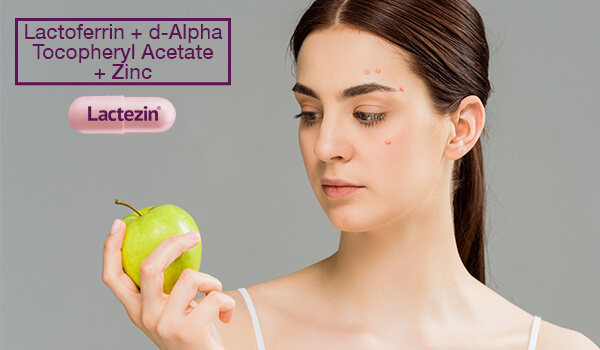Better Together: 5 Skincare Combinations for Acne Care

Some things are just better when they work together. In the case of acne care, there are skincare ingredients that work great on their own but can work wonders when combined. Here, take a look at acne care combos like Lactoferrin, Vitamin E, and Zinc, plus other ingredients that may surprise you!
Layering skincare combinations for acne care
If you’ve suffered from acne, then you’re probably familiar with acne-fighting ingredients like salicylic acid, benzoyl peroxide, and the like, and already know to look for products with these ingredients. However, layering and mixing skincare can be overwhelming. One ingredient may already be working for you, but then you suddenly hear about another ingredient that sounds promising. Then you’re left with a major dilemma: will these ingredients counteract each other and make acne worse, or will they enhance each other and give you the clearer skin you’re hoping for?
Yes, some skincare ingredients do work against each other and may irritate the skin when combined. But there are also skincare ingredient “power couples” that boost each others’ effects.
Here are some acne care ingredient combinations to take note of:
Sunscreen and antioxidants
Daily use of sunscreen is one of the cardinal rules of skin care, regardless of your skin type. For acne-prone skin, sunscreen helps prevent acne flare-ups caused by infrared heat from the sun, as well as hyperpigmentation from sun exposure. In general, sunscreen blocks out harmful free radicals that cause skin damage but on its own, it can only block about 55 percent of free radicals produced by ultraviolet (UV) exposure.
Antioxidants are naturally found in our skin to protect it against free radical damage and other environmental aging factors like smoking and pollution. In a way, they clean up the damage by neutralizing the free radicals that are produced when we are exposed to these toxins.
With antioxidants in sunscreen, the production of these harmful free radicals can be reduced by up to 78 percent. You can also get a similar level of free radical protection when you use antioxidants separately.
Salicylic acid and niacinamide
Salicylic acid is one of the more common acne-fighting ingredients, while you may already be familiar with the skin brightening effects of niacinamide. But did you know, while working in different ways, the two ingredients actually offer similar benefits in terms of fighting acne and skin aging?
An effective exfoliant, salicylic acid helps clear pores by exfoliating from inside the hair follicles of the skin. Because it is oil-soluble, it can access the sebaceous glands and reduce sebum production. On the other hand, niacinamide reduces sebum production by decreasing the fatty acids and glyceride of surface sebum, which improves skin texture and reduces pore size.
Combining the two can have an additive effect in terms of pore size reduction and sebum production, which are two factors that also affect acne.
Resveratrol and glycolic acid
Acne sufferers often have to deal with dark spots that pimples leave behind. For hyperpigmentation, a great skincare combination is resveratrol and glycolic acid.
Resveratrol is a popular antioxidant in the world of anti-aging but it is also known to reduce pigmentation and inflammation by inhibiting tyrosinase, the key enzyme that produces melanin, which gives skin its color. A type of alpha-hydroxy acid, glycolic acid increases the skin’s cell turnover rate, bringing skin pigment to the surface of the skin faster than normal. Research also suggests that like resveratrol, glycolic acid also helps inhibit tyrosinase.
A study has shown that this combination inhibited tyrosinase more effectively than glycolic acid on its own, so if you’re looking to lighten acne marks, this may be worth considering.
AHAs and retinol
Many are wary of this combination because of its potential to irritate the skin but in certain formulas, the combination of AHAs and retinol can be tolerated by the skin and can be an effective acne treatment.
Alpha-hydroxy acids (AHAs) act as chemical exfoliants that slough off dead skin cells at the top layer of the skin, which are useful for treating acne. Retinol also helps improve acne by speeding up skin cell turn over and renewal. Now the combination can be irritating to the skin but certain formulations can be a good addition to an acne care routine.
Lactoferrin, Vitamin E, and Zinc
This acne care combination may not be as common as the others on the list but it is one of the most effective anti-pimple solutions.
Lactoferrin has antibacterial and anti-inflammatory properties that reduce inflammation and overproduction of skin sebum. d-Alpha Tocopheryl Acetate is an antioxidant that helps fight free radicals. Zinc has oil-regulating properties that help improve the skin’s appearance.
These three ingredients are found in Lactezin, an oral medication that helps fight acne, improve skin balance, and maintain healthy skin with correct usage (2x daily).
To learn more about this breakthrough acne solution, click here.
SOURCES:
https://slmdskincare.com/blogs/learn/spf-acne-do-i-need-to-wear-sunscreen-if-i-have-breakouts
https://pubmed.ncbi.nlm.nih.gov/952756/
https://onlinelibrary.wiley.com/doi/abs/10.1111/j.1524-4725.2005.31732
https://www.ncbi.nlm.nih.gov/pmc/articles/PMC3936427/


